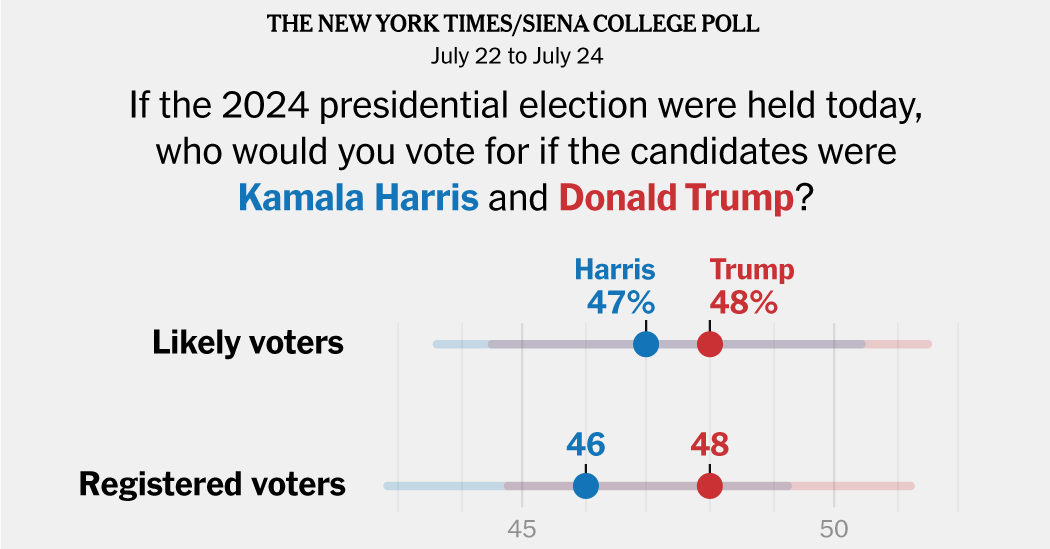

Vice President Kamala Harris begins a 103-day sprint for the presidency in a virtual tie with former President Donald J. Trump, according to the latest New York Times/Siena College poll, as her fresh candidacy was quickly reuniting a Democratic Party that had been deeply fractured over President Biden.
Just days after the president abandoned his campaign under pressure from party leaders, the poll showed Democrats rallying behind Ms. Harris as the presumptive nominee, with only 14 percent saying they would prefer another option. An overwhelming 70 percent of Democratic voters said they wanted the party to speedily consolidate behind her rather than engage in a more competitive and drawn-out process.
Her swift reassembling of the Democratic coalition appeared to help narrow Mr. Trump’s significant advantage over Mr. Biden of only a few weeks ago. Ms. Harris was receiving 93 percent support from Democrats, the same share that Mr. Trump was getting from Republicans.
Overall, Mr. Trump leads Ms. Harris 48 percent to 47 percent among likely voters in a head-to-head match. That is a marked improvement for Democrats when compared to the Times/Siena poll in early July that showed Mr. Biden behind by six percentage points, in the aftermath of the poor debate performance that eventually drove him from the race.
Mr. Trump leads Ms. Harris 48 percent to 46 percent among registered voters. He had led among registered voters by nine percentage points over Mr. Biden in the post-debate poll.
The survey provides a snapshot of the presidential race in the middle of one of the most volatile and unpredictable periods in modern American history. Democrats suddenly have a new nominee. And, less than two weeks after Mr. Trump survived an assassination attempt, his favorability rating rose to the highest level it has ever been in a national New York Times survey.
In some ways, the poll showed a reset to where the race was before Mr. Biden imploded on a debate stage in Atlanta: months of a narrow but steady Trump edge in the national polling averages. But in other ways, the new poll provided intriguing hints at how a Harris candidacy could remake the political coalitions and map that will determine the outcome of the 2024 election.
Ms. Harris was faring better among groups that Mr. Biden had been the weakest in, especially younger voters and nonwhite voters. At the same time, some Democrats fear she might not retain the same strengths that Mr. Biden has had among older voters, for whom the poll does show some erosion of Democratic support.
The poll showed Ms. Harris garnering about 60 percent support from voters under 30 and Hispanic voters, groups Mr. Biden had consistently struggled with. Among voters under 45, Ms. Harris was ahead by 10 percentage points, less than three weeks after Mr. Trump had held a narrow edge with that group over Mr. Biden.
Because the survey was of voters nationwide, the impact of Ms. Harris’s candidacy in particular battleground states was not immediately clear. But a Democratic candidate with greater appeal to younger and more diverse voters could put renewed focus on the Sun Belt states of Nevada, Arizona and Georgia, which had been threatening to slip off the swing-state map for Mr. Biden.
Ms. Harris has emerged as the Democratic Party’s expected nominee after a tumultuous few weeks. Mr. Biden stepped aside on Sunday, following a month of drawn-out questions about his mental faculties following a poor debate performance at the end of June. In the interim, Mr. Trump escaped an assassination attempt, named Senator JD Vance of Ohio as his running mate and formally accepted his party’s nomination at the Republican National Convention.
Ms. Harris is on a glide path toward next month’s Democratic convention as she seeks to become the first woman, first Black woman and first person of South Asian descent to serve as an American president.
“Her being president or even being in the running is very important just for history,” said Summer Nesbitt, a 27-year-old school tutor near Detroit who supports the vice president. But Ms. Nesbitt, who is Black, added that she found some of Ms. Harris’s explicit appeals to Black voters a turnoff. “I don’t think that you have to try to pretend to be more down or be more Black just so you can get the Black vote. Just be yourself.”
Voters are more tuned into the race. Just before the June debate, only 48 percent of voters said they were paying a lot of attention to the presidential campaign. That figure now stands at 64 percent, though the interest of independents continues to lag behind that of Democrats and Republicans.
The national mood remains bleak, but noticeably less so, with 61 percent seeing the country headed in the wrong direction, which is lower than in recent months.
Ms. Harris faces some structural challenges as November approaches. She is the sitting vice president at a time when 75 percent of voters rated the nation’s economic conditions as “fair” or “poor.” And significantly more voters see Mr. Trump as a strong leader than those who say the same of Ms. Harris.
“I’m a Democrat, but I’ve changed my mind after everything that’s happened with Joe Biden’s administration,” said Anna Ayala, a 58-year-old who lives in San Jose, Calif., and voted for Mr. Biden in 2020. She plans to vote for Mr. Trump in 2024. “I mean, the border situation is out of control.”
The country’s view of Ms. Harris has also brightened, with her favorable rating rising by 10 percentage points since February. Ms. Harris enters the campaign with a favorable rating of 46 percent, better than Mr. Biden’s, but still behind Mr. Trump’s.
Views of all three — Mr. Trump, Mr. Biden and Ms. Harris — split dramatically along gender lines. For the most part, men like Mr. Trump while women don’t. Women like Mr. Biden and Ms. Harris, while men don’t.
Mr. Trump’s favorable rating ticked up to 48 percent. This comes not long after the indelible images of him rising to his feet after an assassination attempt at a Pennsylvania rally, pumping his fist in the air as blood streaked across his face, shouting, “Fight! Fight! Fight!”
“Honestly the way he handled it after the fact, the way he pretty much stood up in defiance of what happened, kind of gave me that sense of pride that I hadn’t felt when it came to our country in a while,” said Eddie Otzoy, a 29-year-old contractor in Los Angeles, who had voted for Hillary Clinton in 2016 and Mr. Biden in 2020, but is now backing Mr. Trump. “Once the assassination attempt happened, it made me feel like they wanted to shut him up for a reason.”
Nearly 90 percent of voters said they approved of Mr. Biden’s decision to exit the race, a view shared by Democrats, Republicans and independents alike.
Perhaps as a result, Ms. Harris has almost instantly united the party behind her, to a far greater degree than Mr. Biden had been able to in the last two years. Nearly four in five Democrats or voters who lean toward the Democratic Party said they would like to nominate her. In contrast, only 48 percent of Democrats had said they wanted Mr. Biden as the nominee just three weeks ago.
A majority of Democrats said they felt enthusiastic about Ms. Harris as the nominee, with only 10 percent dissatisfied or angry.
“It would be a larger setback for the Democrats if they try to find someone else to try to fill in,” said Michael Newman, a 59-year-old contractor in Arlington, Texas, who is supporting Ms. Harris. “She has a pretty good insight on the goals that Biden was working on.”
Mr. Biden’s decision not to seek re-election — “I revere this office, but I love my country more,” he said in a national address on Wednesday evening — has resulted in a sharp spike in his favorability rating. The 7-point jump in his favorable rating after three of the most brutal weeks of his presidency — as party leaders questioned his mental competence and fitness — suggested that voter frustration with Mr. Biden may have been based not just on how he was governing but the fact that the 81-year-old president was seeking a second term.
Mr. Biden’s 43 percent favorability rating was his best showing since 2022.
In a multicandidate race, less than a single percentage point separated Mr. Trump and Ms. Harris, with Ms. Harris at 44 percent and Mr. Trump at 43 percent after rounding.
The independent candidate Robert F. Kennedy Jr.’s share of the vote continues to drop, hitting just 5 percent of likely voters in the new survey. He was the only third-party candidate above 1 percent.
Among Ms. Harris and Mr. Trump’s greatest strengths in the poll were that voters saw them as intelligent and having the right temperament to handle the job. Ms. Harris gets slightly higher marks for her smarts; 66 percent of voters say “intelligent” describes her well, compared with 59 percent for Mr. Trump.
Neither candidate holds an edge on the ability to unify the country, a sign that perhaps, in this era of deep political polarization, few believe national unity is even possible.
Here are the key things to know about this Times/Siena poll:
-
Times/Siena polls are conducted by telephone, using live interviewers, in both English and Spanish. About 96 percent of respondents were contacted on a cellphone for this poll. You can see the exact questions that were asked and the order in which they were asked here.
-
Voters are selected for the survey from a list of registered voters. The list contains information on the demographic characteristics of every registered voter, allowing us to make sure we reach the right number of voters of each party, race and region. For this poll, we placed more than 140,000 calls to nearly 54,000 voters.
-
To further ensure that the results reflect the entire voting population, not just those willing to take a poll, we give more weight to respondents from demographic groups that are underrepresented among survey respondents, like people without a college degree. You can see more information about the characteristics of our respondents and the weighted sample at the bottom of the results and methodology page, under “Composition of the Sample.”
-
The poll’s margin of sampling error among registered voters is plus or minus 3.3 percentage points. In theory, this means that the results should reflect the views of the overall population most of the time, though many other challenges create additional sources of error. When computing the difference between two values — such as a candidate’s lead in a race — the margin of error is twice as large.
You can see full results and a detailed methodology here. If you want to read more about how and why we conduct our polls, you can see answers to frequently asked questions and submit your own questions here.
The post Harris Narrows Gap Against Trump, Times/Siena Poll Finds appeared first on New York Times.

